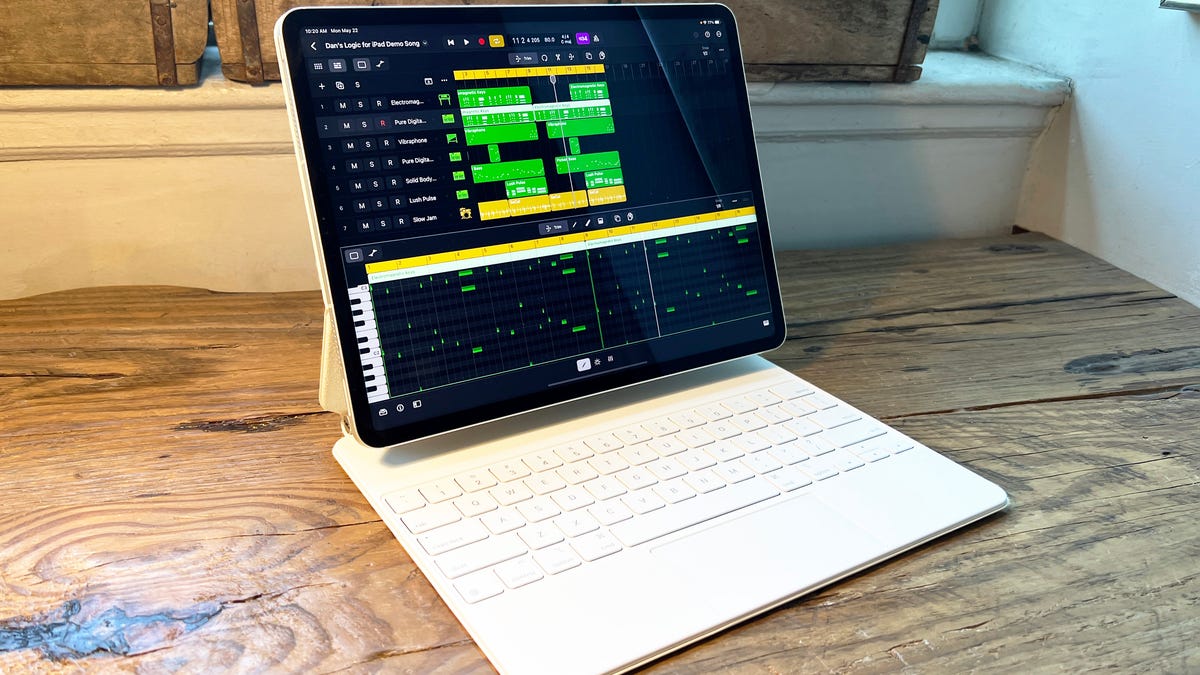 Why You Can Trust CNET
Why You Can Trust CNET Hands-On With Apple's Logic Pro for iPad
Make music on the go with the new iPad version of Apple’s professional audio app.

Apple has long siloed its creative apps into professional and consumer buckets. Pros (or advanced amateurs) used Final Cut for video and Logic Pro for audio, while everyone else used iMovie and GarageBand. Mac users who wanted to upgrade and were willing to pay for the pro-level software could jump from the mainstream apps to the more advanced ones, but iPad owners didn't have that option.
Now that Apple is launching both Final Cut and Logic Pro for iPad, I can see both of these new versions being used for on-the-go production. For example, editing video while on location, or casually putting together beats on a plane or train trip. The new iPad version of Logic Pro is especially interesting to me, as I have a long history of using various digital audio workstation, or DAW, apps over the past 20 years, including ProTools, Adobe Audition and Logic -- even going back so far that I previously used Logic on Windows PCs before Apple bought the brand in 2002.
iPad vs. Mac
I spent several days trying out Logic Pro on an iPad Pro and found the experience to be a mostly familiar one, although some of the navigation can be tricky if you're using a touchscreen interface to recreate what is typically done with a keyboard, touchpad and mouse. Using a keyboard case like Apple's Magic Keyboard helps somewhat, although there's still a learning curve.
But once I got used to manipulating the software through the touchscreen, it opened up new possibilities, and one of my favorite parts of the experience was using my fingers to pinch and zoom on audio waveforms and MIDI data.
The experience is mostly similar to Logic Pro on the Mac, with a few important caveats. First, instead of a flat $199 one-time purchase, as on the Mac platform, both Logic Pro and Final Cut are $5-per-month subscriptions (or $50 annually) on iPad. It's subscription-only, with no one-time-purchase option. Yes, that's the increasingly common standard across many types of software and services, but it also means you'll have to buy one package for Mac and subscribe to a second for iPad if you want to use Logic Pro on both. And you might want to do that, as sessions are transferable between platforms. ProTools also shifted to a (more expensive) subscription-only model last year.
Another potential issue is that third-party plugins will need new iPad versions, which may or may not ever arrive. Many music apps rely on a wide variety of plugins from companies like Waves, and the most famous (or infamous) plugin is probably Antares' Auto-Tune. That said, this is less of an issue for Logic Pro, which has always had a huge collection of included plugins for everything from EQ to mastering to guitar effects, as well as instrument sounds, loops and all the other building blocks needed to make music.
There's also a new feature in the iPad version of Logic called Beat Breaker, which Apple describes as a "time and pitch-morphing plug-in." It lets you take loops and samples, easily cut them into slices and play with the speed, pitch, direction and even order of those slices. It's not for every type of music, but I could see it being interesting for taking stale loops and making them sound fresh and different.
If you're planning to use an external input device, like a MIDI controller, note that it'll need to operate without any special drivers. On a Mac, it's easy to add new drivers, but on the iPad, it's got to be plug-and-play. Fortunately, my Yamaha P-45 digital piano worked fine as a MIDI input device, and that's what I used to create a short demo song.
Making music
I plugged my keyboard into the iPad using a USB-B-to-USB-C cable and was immediately able to start laying down tracks. I haven't used Logic Pro regularly in years, so I went through a few of the included tutorials, which are actual session files that walk you through various features of the app. As far an interactive tutorials go, the lessens included here are pretty good.
This demo is really just a very basic short groove. I laid down a chord progression using an electric piano sound, added some vibraphone licks, bass and pads, all accompanied by Logic Pro's built-in virtual drummer.
Even though the iPad interface took some getting used to, I was able to manipulate individual MIDI notes, change sounds and tweak effects, quantize my playing and do everything I'd expect to from a desktop DAW.
One thing I found useful -- flipping the iPad to a portrait view, I was able to see more of the track view and the mixing board view at the same time. In landscape mode, the mixer view was largely cut off.
If I were working on new music regularly, Logic Pro for iPad would be a great way to do mixing and editing from anywhere, and I especially like being able to prop an iPad on the music stand of my digital piano and connect it via USB-C for real-time recording.
I don't think it's a complete replacement for the Mac-based version of Logic -- sometimes you just need the full keyboard and mouse version (using an iPad Magic Keyboard is close but not perfect), or third-party plug-ins or the ability to jump between other non-iPad apps. And you'll be adding yet another monthly subscription to the ever-growing pile.

